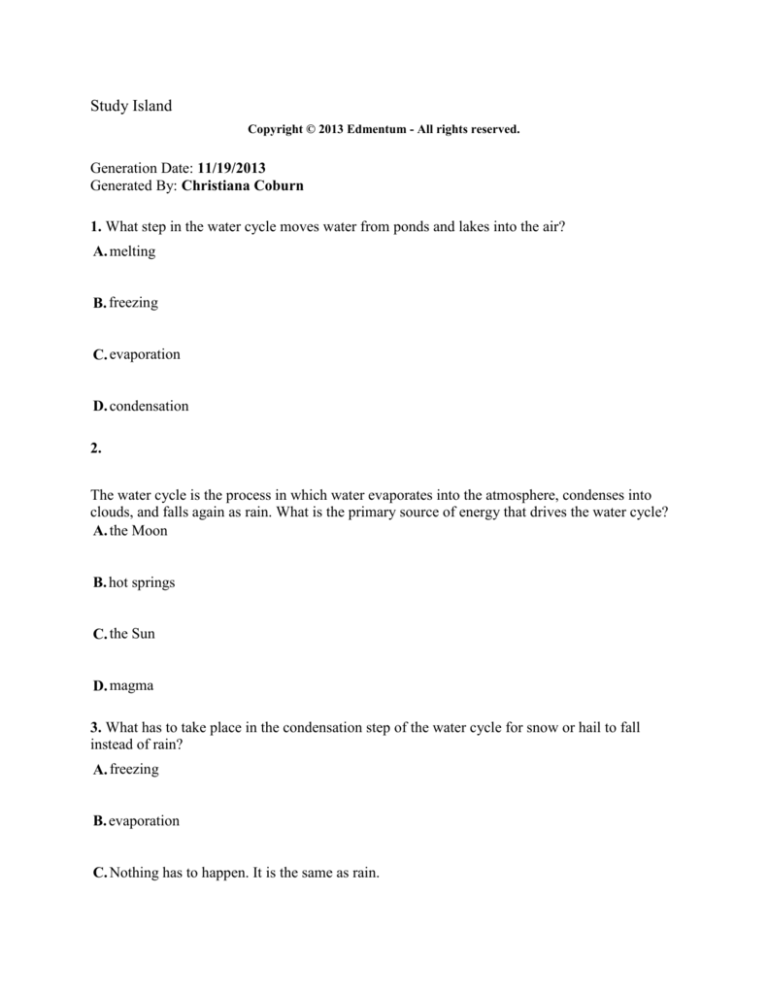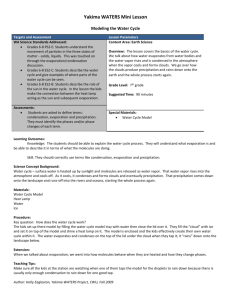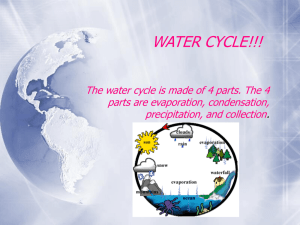
Study Island
Copyright © 2013 Edmentum - All rights reserved.
Generation Date: 11/19/2013
Generated By: Christiana Coburn
1. What step in the water cycle moves water from ponds and lakes into the air?
A. melting
B. freezing
C. evaporation
D. condensation
2.
The water cycle is the process in which water evaporates into the atmosphere, condenses into
clouds, and falls again as rain. What is the primary source of energy that drives the water cycle?
A. the Moon
B. hot springs
C. the Sun
D. magma
3. What has to take place in the condensation step of the water cycle for snow or hail to fall
instead of rain?
A. freezing
B. evaporation
C. Nothing has to happen. It is the same as rain.
D. melting
4. Transpiration is the process in which water moves from the leaves of plants and becomes
water vapor.
Which step in the water cycle is this process part of?
A. evaporation
B. condensation
C. runoff
D. precipitation
5. Which of the following describes the stage that occurs after precipitation in the water cycle?
A. evaporation
B. respiration
C. condensation
D. radiation
6. Water can be found in nature as a solid, liquid, or gas. The repeating steps that water goes
through as it changes state in nature are described by
A. the water cycle.
B. runoff.
C. the ocean.
D. evaporation.
7. Which step in the water cycle can cause flooding?
A. transpiration
B. precipitation
C. evaporation
D. condensation
8. The liquid water in lakes, rivers, and oceans can heat up and change into a gas. This gas is
called water vapor. Water vapor in the air can then cool to form clouds in the sky.
How can water in the atmosphere cycle back to the surface of the Earth?
A. It can flow from rivers into oceans.
B. It can turn back into water vapor.
C. It can fall from clouds as precipitation.
D. It can heat up and rise.
9. Water is recycled in ecosystems. Which of the following is an example of water turning from
a liquid into a gas during the water cycle?
A. Water vapor in the air cools and forms a cloud.
B. Rain falls to the Earth and flows into the ocean.
C. Water in the ocean heats up and turns into water vapor.
D. An animal drinks water from a lake.
10. What is the water cycle?
A.
the movement of water in the ocean against the shore
B.
the movement of water from water sources to your home
C.
D.
the path water follows as it travels from creek to river to the ocean
the path water takes as it circulates from land into the air and back again
11. Which term below refers to water that falls to the Earth in the form of rain, snow, hail, or
sleet?
A. evaporation
B. transfiguration
C. condensation
D. precipitation
12.
The Sun gives water energy. What step in the water cycle happens because of the Sun's energy?
A. runoff
B. precipitation
C. evaporation
D. condensation
13. Before water vapor in the air can condense and fall as rain, it must first evaporate. How does
the Sun help water to evaporate?
A. The Sun stirs the water.
B. The Sun pushes on the water.
C. The Sun heats the water.
D. The Sun cools the water.
14. Which step in the water cycle occurs when gaseous water vapor turns back to liquid water in
clouds?
A. evaporation
B. condensation
C. runoff
D. precipitation
15. Which step of the water cycle is described below?
The water in the air cools off and becomes small droplets of water which stick together to make
clouds.
A. precipitation
B. evaporation
C. photosynthesis
D. condensation
16. Which of the following is an example of precipitation?
A. sleet
B. rain
C. hail
D. all of these
17. Look at the diagram of the water cycle shown below.
Which step of the water cycle is missing from the diagram?
A. radiation
B. condensation
C. precipitation
D. evaporation
18. Water in the atmosphere is in its gas form and is called water vapor. Where does most of the
water vapor in the atmosphere evaporate from?
A. lakes
B. oceans
C. rivers
D. plants
19.
The picture above shows how one material is recycled in ecosystems. This material is _______.
A. food
B. nitrogen
C. carbon
D. water
20. It has been warm and sunny at Gary's house all week.
What step of the water cycle has most likely been taking place near Gary's house?
A. condensation
B. migration
C. evaporation
D. precipitation
21. What energy source helps evaporate water from the Earth's surface in the water cycle?
A. plants
B. Moon
C. gasoline
D. Sun
22. What happens in each step of the water cycle?
A.
B.
C.
D.
Water develops the same physical properties.
Water transforms into other types of liquid.
Water changes from one state to another.
Water becomes a gas in between each step.
23. Which step of the water cycle is described below?
Energy from the Sun heats up water on Earth's surface, and the water goes into the air as water
vapor.
A. reflection
B. condensation
C. evaporation
D. precipitation
24. Clouds can block the sunlight and make the weather cooler.
What step in the water cycle causes cloudy weather?
A. condensation
B. evaporation
C. precipitation
D. runoff
25. Which step of the water cycle is described below?
Water in the clouds falls to the Earth's surface as rain, sleet, snow, or hail.
A. evaporation
B. condensation
C. refraction
D. precipitation
26. It has been warm and sunny at Gary's house all week.
What step of the water cycle has most likely been taking place near Gary's house?
A. evaporation
B. condensation
C. precipitation
D. migration
27. How do the Sun and the ocean interact in the water cycle?
A. The Sun adds water to the ocean.
B. The ocean gives energy to the Sun.
C. The ocean makes water condense.
D. The Sun gives energy to the ocean.
28. Which step in the water cycle is labeled B in the diagram below?
A. transpiration
B. condensation
C. evaporation
D. precipitation
29. What step in the water cycle is shown below?
A. condensation
B. freezing
C. melting
D. precipitation
30.
Which step in the water cycle is labeled by the letter Y?
A. condensation
B. evaporation
C. groundwater
D. precipitation
Answers
1. C
2. C
3. A
4. A
5. A
6. A
7. B
8. C
9. C
10. D
11. D
12. C
13. C
14. B
15. D
16. D
17. B
18. B
19. D
20. C
21. D
22. C
23. C
24. A
25. D
26. A
27. D
28. B
29. D
30. B
Explanations
1. Water from ponds and lakes is moved into the air during evaporation. During the process of
evaporation, water changes from a liquid (water) to a gas (water vapor).
2. Heat from the Sun causes water to evaporate. Later, the water cools in the atmosphere,
condenses, and becomes rain. The rain runs off into lakes and oceans and then evaporates again.
This cycle continues because of the energy from the Sun.
3. For snow to fall instead of rain, the moisture in the air that condenses into clouds must freeze.
Snow and hail are just frozen precipitation.
4. Transpiration is part of the evaporation step in the water cycle because it is one of the
processes by which liquid water returns to the atmosphere as water vapor.
5. After precipitation occurs in the water cycle, evaporation occurs, followed by condensation.
6. The changes in state that water goes through in nature are called the water cycle.
In the water cycle, liquid water evaporates and becomes water vapor in the atmosphere. Water
vapor then condenses and becomes clouds, which are tiny droplets of water. The water in clouds
may fall to the Earth as precipitation. Precipitation can be rain, snow, sleet, or hail. Water that
falls on land may become runoff or groundwater. This water flows toward the ocean.
The process repeats when the water in the oceans or in lakes and streams evaporates again.
7. When the clouds meet cool air over land, precipitation such as rain is triggered, and water
returns to the Earth’s surface. If too much precipitation falls, flooding occurs.
8. Water is recycled in ecosystems. Water vapor in the atmosphere can cool to form clouds. The
water in these clouds can then be returned to the surface of the Earth when it falls from the
clouds as precipitation.
9. Water can change form and location as it cycles through an ecosystem. For example, water
changes from a liquid to a gas when water in the ocean heats up and turns into water vapor.
Water vapor is an invisible gas that is found in the air. When water vapor is cooled to a low
enough temperature, it can condense to form a cloud. Liquid water can then return to the surface
of the Earth through precipitation.
10. The water cycle is the process by which water moves from the Earth's surface into the
air and back down to the Earth again. The cycle's steps reflect water's transformation from a
liquid to a gas or a solid. The steps in the cycle include evaporation, precipitation, condensation,
freezing, and melting.
11. Precipitation refers to any kind of water that falls from the sky as part of the water cycle.
This includes snow, rain, sleet, freezing rain, and hail.
12. Water needs to gain energy energy in order to change from a liquid into a gas. So,
evaporation is the step in the water cycle that happens because of the Sun's energy.
Water loses energy when it changes from a gas to a liquid through condensation and
precipitation.
13. Energy from the Sun heats the water. When water is heated it can evaporate more easily
and become water vapor in the atmosphere.
14. Water vapor condenses into water droplets to form clouds. This step is known as
condensation.
15.
During the condensation stage of the water cycle, the water in the air cools off and becomes
small droplets of water which stick together to make clouds.
16. Precipitation refers to any kind of water that falls from the sky as part of the weather. Snow,
rain, sleet, freezing rain, and hail are all examples of precipitation.
17. Condensation is missing from the diagram of the water cycle. During the condensation
stage, gaseous water vapor cools and becomes liquid water.
18. The liquid water found in the oceans makes up most of the water on Earth. That is why most
of the water vapor in the atmosphere comes from the surface of the oceans.
19. Water is recycled in ecosystems. It cycles from the atmosphere to the surface of the Earth
through the steps of precipitation, surface runoff, evaporation, and condensation.
20. Evaporation happens when liquid water on the ground changes into water vapor gas in the
atmosphere. Evaporation happens faster when the air is warm.
When weather is sunny and warm, there is no rain and there may not be any clouds, so
precipitation and condensation are not taking place.
21. The hot Sun shines on the Earth's surface water, stimulating the liquid to turn into water
vapor.
22. The water cycle is the process by which water moves from the Earth's surface into the air and
back down to the Earth again. The cycle's steps reflect water's transformation from a liquid to a
gas or a solid. The steps in the cycle include evaporation, precipitation, condensation, freezing,
and melting. In each step of the water cycle, water changes from one state to another.
23.
During the evaporation stage of the water cycle, energy from the Sun heats up water on Earth's
surface, and the water goes into the air as water vapor.
24. Condensation is the step in the water cycle that forms clouds.
Condensation happens when water vapor gas in the atmosphere changes into tiny drops of liquid
water.
25.
During the precipitation stage of the water cycle, water in the clouds falls to the Earth's surface
as rain, sleet, snow, or hail.
26. Evaporation happens when liquid water on the ground changes into water vapor gas in the
atmosphere. Evaporation happens faster when the air is warm.
When weather is sunny and warm, there is no rain and there may not be any clouds, so
precipitation and condensation are not taking place.
27. The Sun gives energy to the ocean so that the liquid water can change into water vapor.
This is a very important step in the water cycle.
Most of the water on Earth is in liquid form in the oceans. So, most of the water vapor in the
atmosphere comes from the surface of the oceans.
28. Condensation is the process by which water changes from a gas (water vapor in the air) to
tiny liquid droplets of water which cling together and form clouds.
29. The liquid raindrops falling from the sky onto the Earth's surface are a form of precipitation.
Precipitation refers to any kind of water that falls from the sky as part of the weather.
30. Evaporation is the step in the water cycle in which water in the oceans and in lakes and
streams changes from liquid water into water vapor.
In the water cycle, liquid water evaporates and becomes water vapor in the atmosphere. Water
vapor then condenses and becomes clouds, which are tiny droplets of water. The water in clouds
may fall to the Earth as precipitation. Precipitation can be rain, snow, sleet, or hail. Water that
falls on land may become runoff or groundwater. This water flows toward the ocean.
The process repeats when the water in the oceans or in lakes and streams evaporates again.









